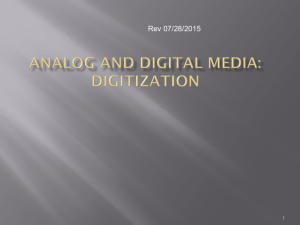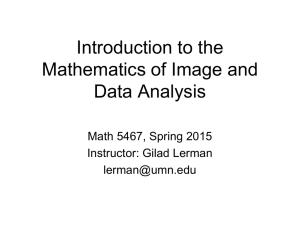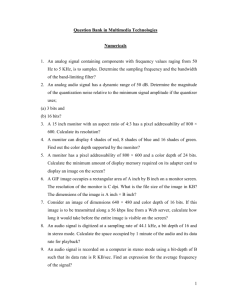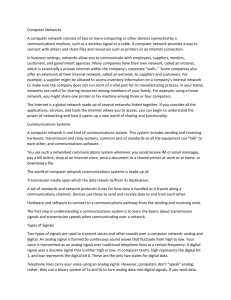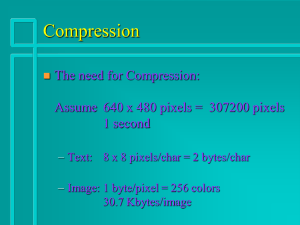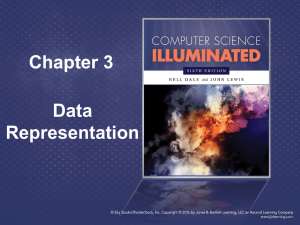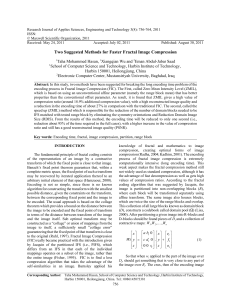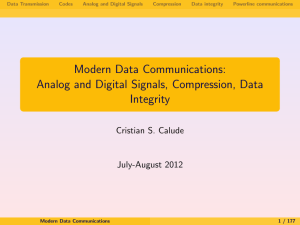Chapter 2 - George Jenkins High School
advertisement
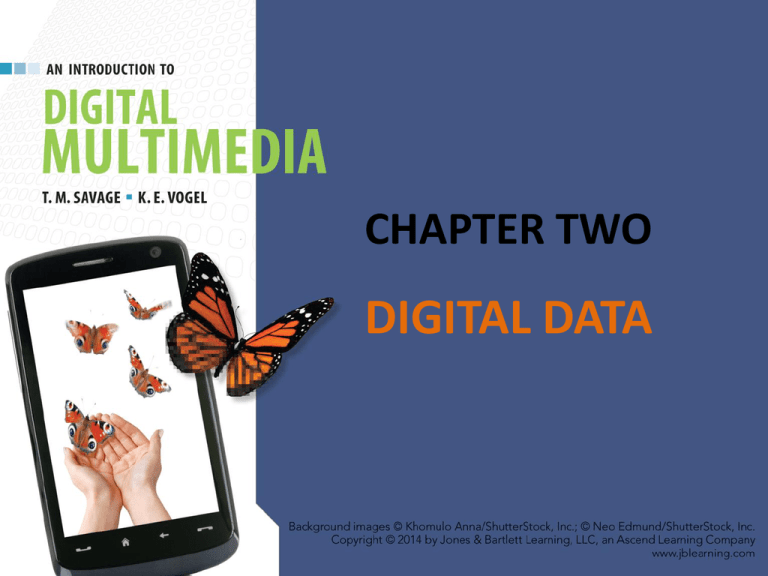
CHAPTER TWO DIGITAL DATA CHAPTER HIGHLIGHTS • • • • • • • Elements of digital media. Digital codes. Digital files. Digitization process. Compression for digital media. Advantages of digital media. Challenges of digital media. 2 CODING DIGITAL INFORMATION • Symbols represent something else. – Organized and understood by a conventional standard. • Data are the givens of experience. – Measurements, facts, observations. • Information is data made useful, interpreted, and applied to produce understanding. 3 YOU DECIDE: data or information? People who are 30 years old, pay $30 to run 30 miles in 30 degree weather for a charity benefit. Age = 30 yrs. Temperature = 30 degrees Distance = 30 mi. Cost = $30 4 ANALOG vs. DIGITAL DATA • Analog data varies continuously. • Digital data consists of separate, discrete units. Wind mill motion. Hour glass to tell time. Numbers 1, 2, 3, 4 YOU DECIDE: Analog or Digital Data? 5 DIGITAL DATA • • • • Digit = number. Binary digit (bit) = 0 or 1. Bits are the symbols to encode digital data. Digital encoding assigns bits to data items. Letter A Number 5 0100 0001 0011 0101 More bits in the code, means more distinct items to encode. 6 BUILDING DIGITAL CODES • Number of distinct bit combinations that can be n. produced is given by the formula 2 – n = number of bits used in the code. • Adding 1 to the power doubles the number of distinct data items that can be encoded. 21 22 23 24 2 items 4 items 8 items 16 items 25 26 27 28 Complete the table to identify the number of distinct items 5, 6, 7, 8. represented by 2 2 2 and 2 7 COMMON CODES • ASCII, a 7 bit code. – 128 letters, numbers, and symbols in English language. • ASCII-8, an 8 bit code. – 256 letters, numbers, and symbols in English language. • Unicode, a 16 bit code. – Over 65,000 different characters. • 24-bit color. – Displays the full range a human eye can perceive. • 16-bit sound. – Plays the full decibel range the human ear can perceive. 8 DIGITAL FILES • A container for binary codes. • File formats define how instructions and data are encoded in the file. – Sample formats that define data differently: • Word file format • Acrobat file format • Media player file format. 9 ALL ABOUT FILES • File size – Measured in units of bytes. • Kilo Bytes, Mega Bytes, Giga Bytes. • File extensions – Series of letters to designate the file format. • .fla, .exe, .rtf, .jpg • File compatibility – Ability to use the file in a different platform of hardware and software. 10 FILE TYPES • Program files – Contain executable instructions. • Data files – Can hold text, images, sounds, video, animation. 11 DATA FILE COMPATIBILITY • Cross-platform compatible files. – Open and use on any computer hardware and software configuration. • Files that are native or specialized to the application that created the data file. – Require source application to open the file. 12 FILE MAINTENANCE • Data loss and destruction impacts multimedia project completion. • Effective file maintenance involves: – Identification – Categorization – Preservation. 13 DIGITIZATION ANALOG TO DIGITAL CONVERSION. 14 SAMPLING ANALOG DATA Sampling analyzes a small portion of the analog source and converts it to digital code. 15 SAMPLE QUALITY • Factors that influence sample quality – Sample Resolution. • Number of bits used to represent digital sample. • Quantization is process of rounding off the value of a sample to the nearest available digital code. – Sample Rate. • Number of samples taken in a given unit of time (sounds) or space (images). • Spatial resolution describes sample rate in image files. 16 YOU DECIDE … sample resolution Which image and sound sample will have better quality? Image Sound 8 bits / sample 8 bits / sample 24 bits / sample 16 bits / sample Which image uses fewer bits to describe the color sample? 17 YOU DECIDE … sample rate Which image and sound sample will have better quality? Why? Image Sound 72 pixels / inch 11 kHz 300 pixels / inch 44 kHz Which image has higher spatial resolution? 50ppi 300ppi 18 DIGITAL ENCODING • Description-based encoding – A detailed representation of the discrete elements that comprise the media. • Command-based encoding – A set of instructions the computer follows to produce the digital media. 19 MEDIA ENCODING COMPARED Description Command Advantages Represent natural scenes and File sizes are small. sounds. Supports detailed editing. Large file sizes. Lose quality if enlarged. Scaled without distortion. Limitations Not appropriate for detailed photographs and natural sounds. Requires knowledge of music and vector image creation. 20 FILE COMPRESSION • Process of re-encoding digital data to reduce file size. • Codec: a program to compress a file into a smaller size and decompress it into a usable form. 21 MAJOR TYPES OF COMPRESSION • Lossy – Number of bits is reduced and some data is lost. – Lossy strategies include MP3 and JPEG compression. • Lossless – Efficient encoding reduces file size without loss of original data. – Lossless strategies include RLE and GIF compression. 22 YOU DECIDE… Lossy or Lossless Choose a compression strategy best suited for: 1. Photograph of sailboat on ocean. 2. Journal article explaining nanotechnology. 3. 1812 Overture by New York Philharmonic Orchestra. 4. Database of student names and addresses. 5. Video of hot air balloon flying over a cornfield. 23 ERROR DETECTION & CORRECTION • Digital bits may be lost during transmission or damaged on storage media. – CDs get scratched. – Communication lines have interference. • Strategies to preserve data vary. – Parity bits help detect an error during transmission. – CDs include redundant data to replace data when an error occurs. 24 DIGITAL INFORMATION — ADVANTAGES • Reproduction without generation decay. • Editing and re-editing much easier than with analog media. • Integration of media using cut, copy, paste more efficient. • Distribution over Internet - nearly everyone can be reached by anyone else. 25 DIGITAL INFORMATION — CHALLENGES • File sizes are large. • Digital media is processor intensive. • Absence of media standards renders data files incompatible. • Some media requires high bandwidth to distribute on networks. • Concern for longevity and future accessibility of digital data. 26 WRAP UP • Analog vs. Digital data. • • • • • • • • Symbols and binary code. Data vs. Information. Files as containers. Digitization process. Description- vs. Command-based media. Compression strategies. Error detection & correction. Advantages & Challenges of digital data. 27 KEY TERM CHECK UP Analog data ASCII ASCII-8 Bandwidth Bit Bitmapped image Byte Codec Command-based Compression Convent ion Data Data file Description-based Digital data Digital encoding Digitization Effective code Efficient code Extended ASCII File compatibility File conve rsion File extension File format Generat ion decay Gigabyte Inco mpatible Infor mation Kilobyte Lossless compression Lossy compression Megabyte MP3 Native file format Parity bit Platform Program file Quant ization RLE Sample rate Sample resolution Sampled sound Sampling Spatial resolution Symbol Terabyte Unicode


